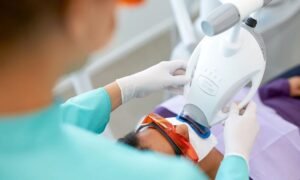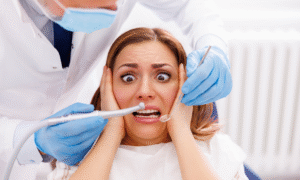In the pursuit of a captivating smile, we delve into the age-old debate of clear aligners vs. braces. This isn’t just about straightening teeth but crafting your unique smile narrative. Navigate the subtleties of clear aligners or embrace the reliability of traditional braces — Flagsmile Dental ensures your decision is empowered and informed. Your journey to a confident smile begins here, where professionalism meets warmth.
The Difference Between Braces and Clear Aligners
While both aim to achieve the same goal of aligning your smile, they differ in treatment approach, visibility, and suitability.
Treatment Approach: A Tale of Two Methods
Braces employ a direct, hands-on approach, utilising brackets and wires to gradually guide your teeth into the desired position. Regular adjustments ensure precise tooth movement, making braces effective in addressing complex orthodontic issues.
Clear aligners, on the other hand, employ a more subtle, indirect approach. Custom-made trays, each slightly different from the last, are worn over your teeth, gradually shifting them into alignment. This method is preferred for those seeking a discreet option.
Visibility: Striking a Balance
Braces are the more noticeable option, with metal brackets and wires affixed to the front of your teeth. While this can be a deterrent for some, braces offer unparalleled visibility for monitoring treatment progress and ensuring precise tooth movement.
Clear aligners, on the other hand, are virtually invisible, making them a popular choice for adults and individuals seeking a discreet orthodontic solution. The trays are clear plastic, blending seamlessly with your natural teeth.
Suitability: Finding the Right Fit
Braces are a versatile treatment option, effectively addressing a wide range of orthodontic issues, from mild misalignment to complex jaw discrepancies. They are particularly well-suited for individuals requiring precise tooth movement or those with non-compliant aligner wear tendencies.
Clear aligners are more appropriate for individuals with mild to moderate orthodontic problems, primarily misaligned teeth or minor crowding. They offer the advantage of discretion and removable trays, making them convenient for social and professional settings.
Addressing Common Concerns
Are Braces Faster Than Clear Aligners?
The duration of treatment varies depending on the severity of the orthodontic issue. Braces generally offer slightly faster results, with treatment typically ranging from 6 to 36 months. Clear aligners may take slightly longer, averaging around 9 to 36 months.
Are Braces More Affordable Than Clear Aligners?
The cost of teeth straightening treatments can vary depending on the complexity of the case and the chosen treatment option. In Australia, the fee for braces is generally between $5,500 and $9,000, while clear aligners range from $3,000 to $8,000.
Benefits of Braces
- Highly effective in correcting various orthodontic issues
- Proven track record of success
- Suitable for a wide range of cases, including severe ones
- Can address jaw alignment issues
- Can have white brackets rather than metal brackets
Benefits of Clear Aligners
- Discreet and virtually invisible
- Removable for eating and brushing
- More comfortable for some individuals
- Easier to maintain oral hygiene
Which is More Comfortable, Aligner or Braces?
Comfort is a significant factor in the decision-making process between Invisalign vs. braces. Clear aligners, known for their discreet and flexible nature, offer a comfortable fit. However, modern braces, including transparent orthodontic braces, have evolved to minimise discomfort, providing an effective and comfortable teeth-straightening experience.
Key Comfort Features:
- Aligners: Seamless fit, absence of sharp edges, and the convenience of removal for meals and oral care.
- Braces: Smoother materials, advancements in design to reduce irritation, and ongoing adjustments for personalised comfort.
Comparing the Benefits: Clear Aligners vs. Braces
In the ongoing debate of benefits, both braces and clear aligners bring unique advantages to the forefront.
Benefits Overview:
- Clear Aligners: Discreet appearance, flexibility in usage, and easy maintenance.
- Braces: Durability, effectiveness in addressing complex cases, and more frequent adjustments for precise and personalised results.
Adjusting to Life with Braces: A Comprehensive Guide
Embarking on the journey with braces requires a bit of adjustment. Here’s a comprehensive guide to make this transition seamless and ensure a successful teeth-straightening experience.
Transitioning Tips:
- Dietary Adjustments: Be mindful of food choices to avoid damaging braces. Opt for softer foods initially and gradually reintroduce a regular diet.
- Oral Care: Learn effective oral hygiene practices with braces, including specialised tools for thorough cleaning. Commit to regular dental check-ups to monitor progress and address any concerns promptly.
- Regular Check-ups: Stay committed to scheduled orthodontic appointments for adjustments and progress checks. These appointments are crucial for fine-tuning the braces and monitoring the overall progress of your teeth straightening journey.
In the ever-evolving realm of teeth straightening, transitioning from clear aligners to braces demands thoughtful consideration and expert guidance. Whether you choose the discreet allure of aligners or the reliability of braces, your path to a captivating smile is uniquely yours.
The Process of Getting Aligners or Braces
Starting the journey with clear aligners to braces can be a seamless transition with proper planning and guidance from your orthodontist. Here’s a step-by-step guide to navigating this process:
Consulting Your Dentist
The initial step is scheduling a comprehensive orthodontic consultation. This vital meeting serves as the foundation for the entire process. During the consultation, discuss any concerns you may have and your aspirations for the teeth-straightening journey. This open dialogue ensures that both you and your orthodontist are aligned on the goals and expectations.
Customising Your Treatment Plan
Following the consultation, your orthodontist will craft a customised treatment plan tailored to your unique dental needs. This plan takes into account factors such as the current state of your teeth, the desired outcome, and any specific challenges. The personalised nature of this plan ensures that your teeth straightening experience is effective and aligned with your individual requirements.
What to Expect
Starting your teeth straightening journey involves a period of adjustment. Understanding what to expect is crucial for a smooth experience. Be prepared for:
- Temporary Discomfort: It’s normal to experience some discomfort as your teeth adapt to the braces or clear aligners. This discomfort is temporary and can be managed with dentist-recommended solutions.
- Oral Care Adjustments: Your oral care routine may need adjustments. Your orthodontist will provide guidance on specialised dental care, ensuring optimal hygiene throughout the treatment.
- Regular Check-ups: Expect regular check-ups to monitor your progress, make necessary adjustments and address any concerns promptly. These check-ups are integral to the success of your braces journey.
Open communication, personalised treatment plans, and knowing what to expect to pave the way for a successful and fulfilling experience.
Conclusion:
From treatment approaches to visibility and suitability, we’ve provided insights into the differences between braces and clear aligners. Each method has strengths; your choice should align with your lifestyle and orthodontic needs.
Concerned about duration and affordability? We’ve clarified that both options have distinct benefits, and the decision depends on what suits you best. Whether it’s a new journey or a transition, Flagsmile Dental is here with professional guidance and a touch of human warmth. Your smile narrative is our priority, and we’re dedicated to helping you achieve a confident, luminous smile.
FREQUENTLY ASKED QUESTIONS
The choice between clear aligners and braces hinges on individual needs. Clear aligners offer discreetness and flexibility, while braces are reliable for complex cases. The decision should align with your lifestyle and orthodontic requirements, ensuring a personalised fit for your journey to a straighter smile.
Braces and Invisalign cater to different needs. Braces, with their versatility, are effective for various cases, while Invisalign provides a discreet option for mild to moderate issues. Considering both effectiveness and personal preferences, the decision should align with your orthodontic goals.
While discomfort is common with both options, clear aligners are generally associated with less pain. Modern braces, incorporating advanced pain management techniques, aim to minimise discomfort. Individual experiences vary; your orthodontist can guide you on effective pain management strategies.
The speed of teeth straightening depends on the complexity of the case. Braces may yield slightly faster results, but the difference is case-specific. Your orthodontist can provide insights into the expected duration based on your unique case.
Perceptions of clear aligners being faster stem from its discreet approach and customised treatment plans. However, the actual duration varies based on individual cases and specific treatment plans. It’s essential to consult with your orthodontist for a realistic understanding of the expected timeline.

Dr Ann Chen
Dr. Ann Chen is a passionate dentist dedicated to empowering people through their smiles. Graduating with an Academic Award from the University of Queensland in 2009, she has extensive experience in both private practice and Queensland Health. Dr. Ann's special interests lie in children's dentistry, orthodontics, and dental implants. Alongside her dental pursuits, she enjoys leisurely moments at home with her husband, taking walks in the park, cooking together, and even embarking on the occasional bicycle ride across Brisbane. Dr. Ann can also understand Mandarin. Visit Dr. Ann to experience her commitment to providing exceptional dental care and inspiring young minds to pursue dentistry.






